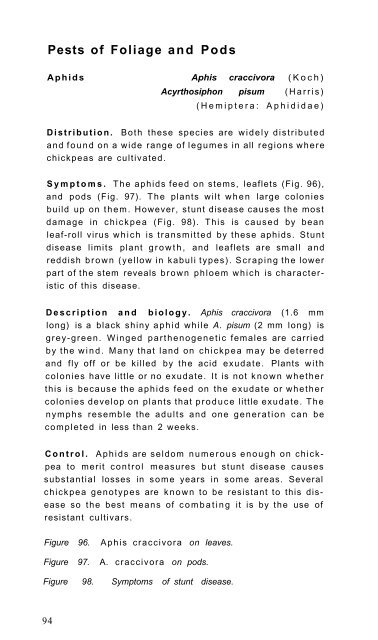Pigeonpea and Chickpea Insect Identification Handbook - Agropedia
Pigeonpea and Chickpea Insect Identification Handbook - Agropedia
Pigeonpea and Chickpea Insect Identification Handbook - Agropedia
You also want an ePaper? Increase the reach of your titles
YUMPU automatically turns print PDFs into web optimized ePapers that Google loves.
Pests of Foliage <strong>and</strong> Pods<br />
A p h i d s Aphis craccivora ( K o c h )<br />
Acyrthosiphon pisum ( H a r r i s )<br />
( H e m i p t e r a : A p h i d i d a e )<br />
D i s t r i b u t i o n . Both these species are w i d e l y d i stributed<br />
<strong>and</strong> f o u n d on a wide range of l e g u m e s in all regions where<br />
chickpeas are cultivated.<br />
S y m p t o m s . T h e aphids feed on stems, leaflets (Fig. 96),<br />
<strong>and</strong> pods (Fig. 97). T h e plants wilt w h e n large colonies<br />
build up on t h e m . However, stunt disease causes the most<br />
damage in c h i c k p e a (Fig. 98). This is caused by bean<br />
leaf-roll virus w h i c h is transmitted by these aphids. Stunt<br />
disease limits plant g r o w t h , <strong>and</strong> leaflets are small <strong>and</strong><br />
reddish b r o w n (yellow in kabuli types). S c r a p i n g the lower<br />
part of the stem reveals b r o w n phloem w h i c h is characteristic<br />
of this disease.<br />
D e s c r i p t i o n a n d b i o l o g y . Aphis craccivora (1.6 mm<br />
long) is a black shiny a p h i d while A. pisum (2 mm long) is<br />
grey-green. Winged p a r t h e n o g e n e t i c females are carried<br />
by the w i n d . Many that l<strong>and</strong> on c h i c k p e a m a y be deterred<br />
<strong>and</strong> fly off or be killed by the acid exudate. Plants w i t h<br />
colonies have little or no exudate. It is not k n o w n whether<br />
this is because the aphids feed on the exudate or whether<br />
colonies develop on plants that p r o d u c e little exudate. T h e<br />
n y m p h s resemble the adults <strong>and</strong> one g e n e r a t i o n can be<br />
completed in less than 2 weeks.<br />
C o n t r o l . A p h i d s are seldom n u m e r o u s e n o u g h on chickpea<br />
to merit c o n t rol measures but stunt disease causes<br />
substantial losses in s o m e years in some areas. Several<br />
chickpea genotypes are k n o w n to be resistant to this disease<br />
so the best means of c o m b a t i n g it is by the use of<br />
resistant cultivars.<br />
Figure 96. Aphis craccivora on leaves.<br />
Figure 97. A. craccivora on pods.<br />
Figure 98. Symptoms of stunt disease.<br />
94

















